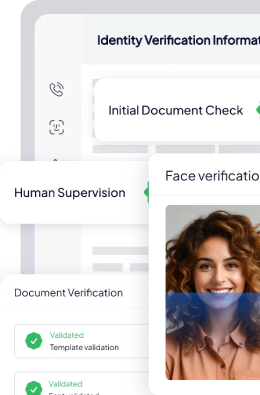Introduction
In the digital age, the banking sector continually strives to enhance its security measures and streamline processes for its customers. Bank Account Verification API has emerged as a game-changing tool for achieving both goals simultaneously. This article delves into the significance of API in the banking sector, its working mechanism, advantages, challenges, and its impact on customer experience.
Understanding Bank Account Verification API
Our API is an application programming interface that allows banks and financial institutions to verify the authenticity and accuracy of their customers’ bank accounts. It acts as an intermediary between the banking system and third-party applications, facilitating seamless data exchange in real time.
The Importance of Bank Account Verification
Accurate and reliable account verification is crucial for various banking operations. It helps prevent fraudulent activities, identity theft, and money laundering. By verifying customers’ bank accounts, financial institutions can ensure that the right individuals have access to the appropriate services, thus enhancing security and trust.
Advantages of Using Surepass’s Bank Account Verification API in the Banking Sector
Enhanced Security
Surepass’s API employs robust algorithms and verification processes to validate customer information. It reduces the risk of unauthorized access to sensitive financial data, safeguarding both customers and the banking institution.
Improved Efficiency
With traditional verification methods, the process of verifying bank accounts can be time-consuming and error-prone. Bank Verification API automates this process, allowing banks to perform real-time verifications swiftly and accurately.
Cost Savings
By automating the verification process, banks can significantly reduce manual intervention, leading to cost savings in operational expenses. Moreover, it minimizes the losses incurred due to fraudulent activities.
How Bank Account Verification API Works
Customer Information Input
Customers provide their bank account details through the application, which are then sent to the API.
Data Validation and Verification
The API validates the provided data, cross-referencing it with the bank’s database and other reliable sources.
Verification Results
The API generates a verification report, indicating the accuracy and legitimacy of the provided bank account information.
Bank Account Verification API India
The adoption of APIs in India has been on the rise due to the country’s digital transformation in the banking sector. It has not only improved security but also facilitated financial inclusion by making banking services more accessible.
Accelerating Financial Inclusion
India’s diverse population has varying levels of access to traditional banking services. Bank Account Verification API has played a crucial role in bridging this gap by enabling online account verification and creating opportunities for the unbanked.
Simplifying Digital Transactions
As India moves towards a cashless economy, the ease of conducting digital transactions becomes paramount. Bank Account Verification API ensures seamless and secure fund transfers, boosting digital payment adoption.
Complying with Regulatory Requirements
Financial institutions in India are subject to stringent regulatory requirements, especially in the context of Know Your Customer (KYC) and Anti-Money Laundering (AML) regulations. Bank Account Verification API aids banks in adhering to these compliance standards efficiently.
Automate your KYC Process & reduce Fraud!
We have helped 200+ companies in reducing their user onboarding TAT by 95%
Key Players in Bank Account Verification API Services
The demand for Bank Account Verification API has given rise to several service providers specializing in this domain. The prominent player in this industry is Surepass. Our company offers unique features and capabilities, catering to the diverse needs of banking institutions.
Integrating Bank Account Verification API into Banking Systems
The successful integration of API into existing banking systems requires careful planning and implementation. Financial institutions need to ensure seamless integration without compromising data integrity or system stability.
Seamless Implementation Strategies
Banks must adopt well-defined implementation strategies to ensure a smooth transition to Bank Account Verification API. Collaborating with “Surepass” (#1API Provider) can streamline the integration process.
Ensuring Data Integrity
Integrating the API necessitates the secure transfer of customer data. Banks must prioritize data encryption, secure data storage, and access controls to maintain data integrity and confidentiality.
Enhancing User Experience
Customer experience is paramount in the banking sector. By integrating our API, banks can simplify and expedite verification processes, leading to improved user satisfaction. A user-friendly interface and prompt verification results contribute to a positive customer experience.
Common Challenges and Solutions
The implementation of the Bank Account verify API may present certain challenges that banks need to address effectively. By proactively identifying and tackling these challenges, banks can maximize the benefits of the API.
Data Discrepancies and Quality
One of the common challenges is the presence of discrepancies in customer data. Customers may provide inconsistent or outdated information, leading to verification errors. Banks can mitigate this challenge by conducting regular data cleansing and verification checks. Educating customers about the importance of providing accurate information can also contribute to better data quality.
Technical Integration Issues
Integrating a new API into existing banking systems can be complex, and technical glitches may occur during the process. Banks can collaborate closely with us to ensure seamless integration. Rigorous testing and quality assurance measures are essential to identify and resolve any technical issues before going live.
Customer Awareness and Education
Some customers may be unfamiliar with the concept of Bank Verification API and its benefits. A lack of awareness can result in resistance or reluctance to use the API. Banks can address this challenge by launching educational campaigns to inform customers about the advantages of the API, such as enhanced security and faster verification.
Future Trends in Bank Account Verification API
As technology continues to evolve, Verification APIs are poised to witness significant advancements that further enhance their capabilities and functionalities.
Artificial Intelligence and Machine Learning Integration
AI-driven verification processes can enhance the accuracy and efficiency of Bank Verification API. Machine learning algorithms can analyze historical data patterns and detect potential fraud attempts, making the API more robust against emerging threats.
Biometric Verification Advancements
Biometric verification, such as fingerprint and facial recognition, is gaining popularity in the banking sector. Integrating biometric authentication with Account Verification API can add an extra layer of security, making it even more challenging for unauthorized individuals to gain access to sensitive financial data.
Blockchain-based Verification Solutions
Blockchain technology offers decentralized and tamper-resistant verification capabilities. By leveraging blockchain, banks can create a secure and transparent ecosystem for verifying bank accounts, ensuring data integrity, and enhancing customer trust.
The Role of Bank Account Number Verification API
While Bank Account Verification API serves as a comprehensive verification tool, the Bank Account Number Verification API has specific functions related to account numbers.
Additionally, you may leverage additional APIs from Surepass, the leading API provider in India, for various use cases for quick and simple verification procedures. Additionally, you will learn about a variety of APIs here, including the Aadhaar verification API, Pan verification API, Passport verification API, IEC verification API, and many other verification APIs.
Validating Account Numbers
Ensuring the correctness of account numbers is crucial to avoid errors in fund transfers. Bank Account Number Verification API verifies the validity and structure of account numbers, reducing the likelihood of failed transactions.
Efficient Electronic Fund Transfers
Smooth and error-free electronic fund transfers are vital for efficient banking operations. Bank Account Number Verification API plays a pivotal role in streamlining these transactions, ensuring successful transfers without delay.
Enhancing Payment Security
In an era where digital payments are prevalent, the Bank Account API acts as a safeguard against unauthorized transfers. By verifying the accuracy of account numbers before processing payments, banks can prevent fraudulent transactions.
Leveraging Bank Account Validation API for KYC Compliance
Compliance with Know Your Customer (KYC) regulations is a top priority for banks and financial institutions. Bank Account Validation API simplifies the KYC process while ensuring adherence to regulatory requirements.
Simplifying KYC Processes
Traditional KYC processes can be time-consuming and cumbersome. Bank Account Validation API automates data verification, streamlining the KYC process and expediting customer onboarding.
Reducing KYC Processing Time
Bank Account Validation API enables real-time verification of customer data, significantly reducing the time required to complete the KYC process. This not only boosts client satisfaction but also operational effectiveness.
Mitigating Identity Fraud
Identity fraud is a persistent concern in the banking sector. By using Bank Account Validation API to verify customer identities, banks can significantly reduce the risk of fraudulent activities and protect both customers and themselves.
Bank Account Verification API vs. Traditional Verification Methods
Comparing Bank Account Number Verification API with traditional verification methods highlights the advantages of speed, accuracy, and cost-effectiveness offered by the API.
Speed and Efficiency Comparison
Traditional verification methods often involve manual processes and back-and-forth communication, resulting in longer verification times. Bank Account Verification API performs verifications in real-time, enabling swift and seamless account validation.
Accuracy and Reliability Assessment
Human errors can occur during manual verification, leading to inaccuracies. Bank Verification API, with its automated processes and data cross-referencing, ensures a higher level of accuracy and reliability in verifying bank accounts.
Cost-effectiveness Evaluation
Manual verification processes can be labor-intensive and costly. Bank Account Number Verification API reduces the need for manual intervention, translating into cost savings for banks while maintaining high verification standards.
Ensuring Customer Privacy and Data Protection
Banks must prioritize data privacy and protection while leveraging Bank Verification API. It is crucial to implement strong security measures and follow data protection laws.
Robust Security Measures
To ensure customer privacy and data security, banks must adopt state-of-the-art security measures. Encryption protocols, firewalls, and multi-factor authentication are some of the measures that can safeguard sensitive customer data.
GDPR and Data Compliance
For banks operating in regions governed by data protection regulations like the General Data Protection Regulation (GDPR), compliance is crucial. Account Verification API providers must adhere to these regulations to protect customer data and maintain legal compliance.
Building Customer Trust
Customers are more likely to use Bank Verification API if they have trust in the security and privacy of the system. Banks can build trust by being transparent about data handling practices and keeping customers informed about the security measures in place.
Conclusion
Bank Account API has revolutionized the banking sector by bolstering security measures, streamlining operations, and enhancing customer experience. Its adoption in India and around the world signifies the industry’s commitment to harnessing technology for a safer and more efficient banking ecosystem. As technology continues to advance, Bank Account Number Verification API will continue to play a vital role in ensuring secure and efficient banking transactions, fostering financial inclusion, and meeting regulatory requirements.
FAQs
-
What is the Bank Verification API?
It is an application programming interface that allows banks to verify the authenticity and accuracy of their customer’s bank accounts in real-time.
-
Why is Bank Account Verification important for the banking sector?
It is very crucial to prevent fraud, identity theft, and money laundering while ensuring that the right individuals have access to the right services.
-
How does Bank Verification API work?
Customers provide their bank account details, which are then validated and cross-referenced with the bank’s database to generate a verification report.
-
What are the advantages of using the Bank Verification API?
The advantages include enhanced security, improved efficiency, and cost savings due to reduced manual intervention.





